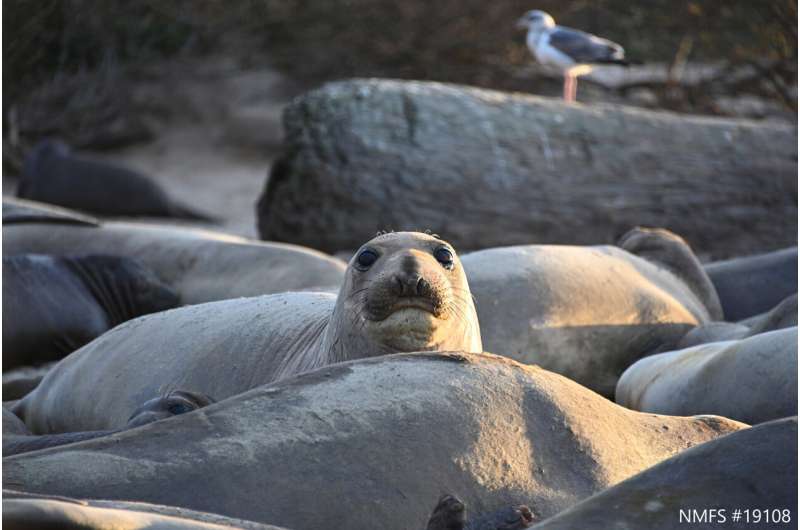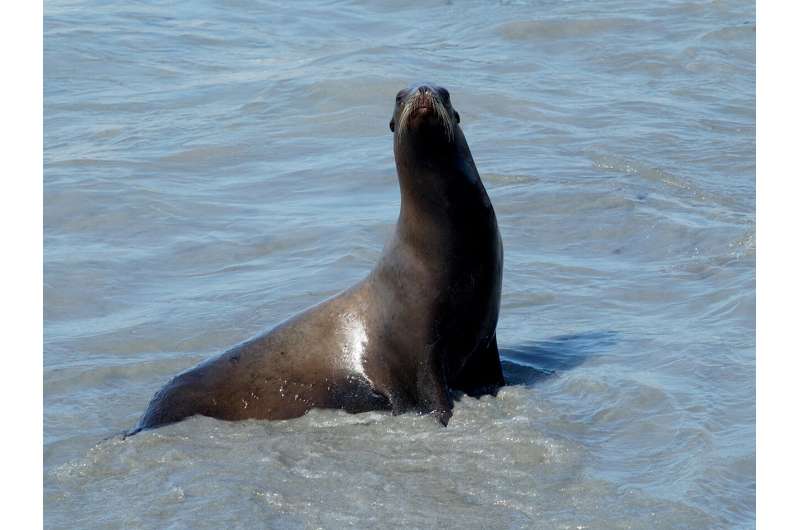Different reproductive strategies can lead to differences in the resilience of a species to disturbance by human activities. The Northern elephant seal is a "capital breeder"—the female stores energy for nursing her pup during a long foraging migration. After giving birth, the mother does not need to leave her pup to feed. Credit:Dan Costa
From seismic surveys and Navy sonar to fisheries and shipping, many human activities in the ocean environment cause short-term changes in the behaviors of marine mammals. A longstanding challenge for scientists and regulatory agencies alike has been to understand the biological significance of those changes in terms of their overall impact on affected populations of animals.
A new study led by scientists at the University of California, Santa Cruz, provides a comprehensive framework for conducting this type of assessment. Published August 25 in Proceedings of the Royal Society B, the paper synthesizes a huge amount of knowledge about marine mammals and research on the impacts of various disturbances.
Senior author Daniel Costa, professor of ecology and evolutionary biology and director of the Institute of Marine Sciences at UC Santa Cruz, said he first began grappling with this problem decades ago when he was studying the impact of low-frequency sound on whales and other marine mammals. "We had measurable parameters that were statistically significant, but we didn't know the biological significance of these changes in behavior. That bothered me, and it bothered a lot of other people in the field," he said.
A 2005 report from the National Research Council led to the development of an approach, known as the Population Consequences of Disturbance (PCoD) framework, which can be used to assess the bioenergetic costs of behavioral changes. Since then, researchers have been developing quantitative models of PCoD for different species and types of disturbances.
"These models provide a lot of information, but we wanted to take a holistic approach by identifying the common themes and using those concepts to inform how wildlife managers and others can go about assessing the risks of a proposed activity," said first author Kelly Keen, a UCSC graduate student who previously worked for the California State Lands Commission as an environmental scientist. "Coming from state government and having done a lot of risk assessments, I was interested in how these quantitative models can be applied."
The new study highlights the importance of life history traits such as reproductive strategies, movement patterns, body size, and pace of life in determining the vulnerability of a species to different types of disturbances. For example, Costa explained how differences in breeding behavior can make California sea lions less resilient than northern elephant seals.
"The California sea lion lives paycheck to paycheck," he said. "The mom has her pup on the beach, and then she goes out to sea to feed, comes back and suckles her pup, then goes back out and feeds again. She's restricted to a relatively small area and can't go far from the colony, so if there's a disturbance that affects her feeding, that has a big impact because she doesn't have money in the bank."
Different reproductive strategies can lead to differences in the resilience of a species to disturbance by human activities. The California sea lion is an "income breeder"—to acquire energy for lactation, the female has to leave her pup on the beach and go to sea repeatedly to feed. Credit: Dan Costa
Elephant seal moms, on the other hand, have money in the bank. They migrate great distances across the North Pacific Ocean, feeding and storing energy, so when they come back to the colony to give birth they can stay on the beach with their pup. "They don't feed while they're nursing, they just dump all that stored energy into the pup," Costa said. "They're more resilient because they cover such a large area while they're feeding and can more easily avoid any given stressor."
As a result, if there are both elephant seals and sea lions in an area where a proposed activity could disturb them, the sea lion population is likely to be at greater risk. Similarly, different considerations apply to species with a "live fast, die young" pace of life and a high reproductive rate, such as harbor porpoises, versus a large whale species that is slow to mature and reproduce.
"What regulators really want is a tool where you can plug in the numbers and the species and it spits out an answer," Costa said. "We're not there yet, but this is the next best thing. It tells you the key characteristics you need to consider in making a decision."
In addition to life history features, the paper outlines the importance of the specific characteristics of the disturbance, including its location, duration, and frequency. Environmental conditions, including climate change, can also influence a population's sensitivity to disturbances, Keen said.
"These models are steeped in the bioenergetics framework, so we looked at prey availability and how that could be affected by environmental conditions in a specific area, because if there is an overlapping disturbance in that area, that could have consequences for the population," she said.
Costa noted that California's coastal waters, with the most diverse marine mammal fauna in the world, is a particularly challenging place to do this type of risk assessment. Although he doesn't expect to see new offshore oil development, the move toward renewable energy resources means a growing number of proposals to develop offshore wind and wave power in California.
"In deciding where to put something like that, a complete quantitative assessment is always going to be difficult," Costa said. "With this conceptual process, we can at least make informed judgments. It's a tool that can tell you what considerations you need to be thinking about."
More information: Kelly A. Keen et al, Emerging themes in Population Consequences of Disturbance models, Proceedings of the Royal Society B: Biological Sciences (2021). DOI: 10.1098/rspb.2021.0325
Journal information: Proceedings of the Royal Society B
Provided by University of California - Santa Cruz
























